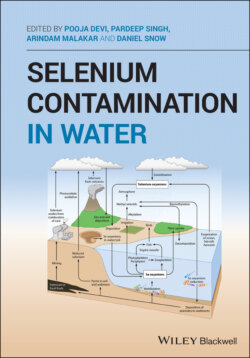Читать книгу Selenium Contamination in Water - Группа авторов - Страница 35
3.1.3 Chemical and Physical Properties
ОглавлениеSe is a fairly reactive element. It is 16 Group element with a melting point of 317.3 K, a boiling point of 553.7 K, and density of 1.823 g/cm3. Se is placed in the oxygen group of the periodic table. It usually occurs in combination with metals like mercury, copper, silver, or lead (Guoxiong Hua 2011).
It combines easily with hydrogen, fluorine, chlorine, and bromine. It reacts with nitric and sulfuric acids. It also combines with a number of metals to form compounds called selenides such as magnesium selenide (MgSe). Se dioxide has a characteristic odor of rotten horseradish.
The Pauling scale electronegativity of Se is 2.55, which is slightly lower than oxygen due to the size of atom indicated by van der Waals and ionic radius as 0.14 and 0.198 nm respectively. The energy required to remove the first electron from the valence shell is 940.7 kJ/mol, which is quite lower than that required for the second and third electrons, as removal of one electron leads to stability of the atom (Brown 1914). Se and tellurium are often associated with each other. They tend to occur together in the Earth and have somewhat similar properties.
